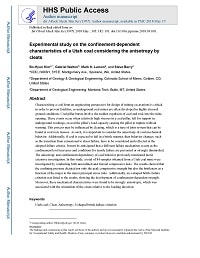Mining Publication: Experimental Study on the Confinement-Dependent Characteristics of a Utah Coal Considering the Anisotropy by Cleats
Original creation date: May 2018
Authors: B Kim, G Walton, M Larson, S Berry
Characterizing a coal from an engineering perspective for design of mining excavations is critical in order to prevent fatalities, as underground coal mines are often developed in highly stressed ground conditions. Coal pillar bursts involve the sudden expulsion of coal and rock into the mine opening. These events occur when relatively high stresses in a coal pillar, left for support in underground workings, exceed the pillar’s load capacity causing the pillar to rupture without warning. This process may be influenced by cleating, which is a type of joint system that can be found in coal rock masses. As such, it is important to consider the anisotropy of coal mechanical behavior. Additionally, if coal is expected to fail in a brittle manner, then behavior changes, such as the transition from extensional to shear failure, have to be considered and reflected in the adopted failure criteria. It must be anticipated that a different failure mechanism occurs as the confinement level increases and conditions for tensile failure are prevented or strongly diminished. The anisotropy and confinement dependency of coal behavior previously mentioned merit extensive investigation. In this study, a total of 84 samples obtained from a Utah coal mine were investigated by conducting both unconfined and triaxial compressive tests. The results showed that the confining pressure dictated not only the peak compressive strength but also the brittleness as a function of the major to the minor principal stress ratio. Additionally, an s-shaped brittle failure criterion was fitted to the results, showing the development of confinement-dependent strength. Moreover, these mechanical characteristics were found to be strongly anisotropic, which was associated with the orientation of the cleats relative to the loading direction.

- 60 Years of Rockbursting in the Coeur D'Alene District of Northern Idaho, USA: Lessons Learned and Remaining Issues
- Behavior of a Coal Pillar Prone to Burst in the Southern Appalachian Basin of the United States
- Cleat in Bituminous Coalbeds
- Coal Bumps and Odd Dynamic Phenomena - A Numerical Investigation
- Development of a Statistical-Analytical Approach for Assessing Coal Bump Potential
- Diagnosing and Controlling Moisture-Sensitive Roof in Coal Mines
- Dynamic Failure in Deep Coal: Recent Trends and a Path Forward
- Effects of Weak Bands on Pillar Stability in Stone Mines: Field Observations and Numerical Model Assessment
- Investigation of a Rock-Burst Site, Sunshine Mine, Kellogg, Idaho
- Pillar Stability Issues Based on a Survey of Pillar Performance in Underground Limestone Mines